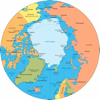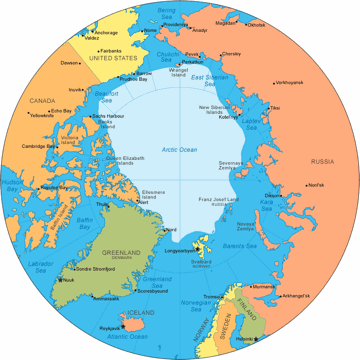 WITHIN 60 years the Arctic Ocean could be a stagnant, polluted soup. Without drastic cuts in greenhouse-gas emissions, the Transpolar Drift, one of the Arctic's most powerful currents and a key disperser of pollutants, is likely to disappear because of global warming.
WITHIN 60 years the Arctic Ocean could be a stagnant, polluted soup. Without drastic cuts in greenhouse-gas emissions, the Transpolar Drift, one of the Arctic's most powerful currents and a key disperser of pollutants, is likely to disappear because of global warming.
The Transpolar Drift is a cold surface current that travels right across the Arctic Ocean from central Siberia to Greenland, and eventually out into the Atlantic. It was first discovered in 1893 by the Norwegian explorer Fridtjof Nansen, who tried unsuccessfully to use the current to sail to the North Pole. Together with the Beaufort Gyre, the Transpolar Drift keeps Arctic waters well mixed and ensures that pollution never lingers there for long.
To better understand the dispersal of pollution in the Arctic Ocean, Ola Johannessen, director of the Nansen Environmental and Remote Sensing Center in Bergen, Norway, and his colleagues studied the spread of radioactive substances such as strontium-90 and caesium-137 from (see Russia's toxic shocker) nuclear testing, bomb factories and nuclear power-plant accidents. Measurements taken between 1948 and 1999 were plugged into a high-resolution ocean circulation model and combined with a climate model to predict Arctic Ocean circulation until 2080.
Their model confirmed that most pollutants, including pesticide, petroleum residue and nuclear fallout, are currently washed out into the north Atlantic by the Transpolar Drift. But perhaps not for much longer. In a nuclear accident, more radioactive material would be contained in the Arctic Ocean for much longer.

In a "business-as-usual" scenario, in which atmospheric carbon dioxide levels double by 2070, Johannessen and his colleagues found that the Transpolar Drift stops and the Beaufort Gyre, Greenland Current and Gulf Stream weaken considerably (Journal of Environmental Radioactivity, DOI: 10.1016/j.jenvrad.2009.01.003). One reason for this sluggish behaviour is a change in wind patterns driven by global warming and rapid melting of the Arctic sea ice.
As a result, pollution takes much longer to disperse in this scenario. Much of this pollution would congregate along the non-European coastlines of the Arctic Ocean, the model suggests.
Jeff Ridley of the Met Office Hadley Centre in Exeter, UK, agrees that surface circulation in the Arctic Ocean will weaken if sea ice disappears, but he doubts it will happen quite so fast. He also points out that other currents in the region would continue to disperse pollutants.
* * * * *
This report appeared in New Scientist on 06 August 2009, at newscientist.com. For similar stories, visit the New Scientist's Climate Change Topic Guide
This report and many related reports are circulated in the Global Warming Crisis Council listserve, which you can join at GWCC sign up. Alternatively, you can send a blank email to gwcc-subscribe "at" lists "dot" riseup "dot" net (using the email address you would like to subscribe with).
This article is published under Title 17 U.S.C. Section 107. See the Fair Use Notice for more information.

